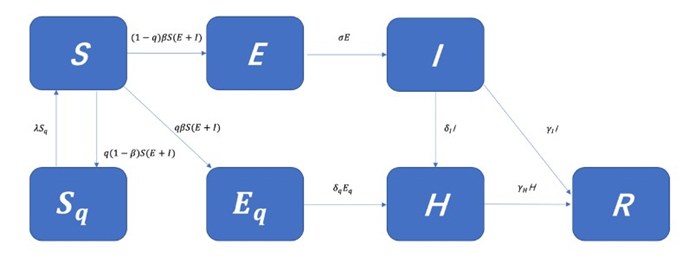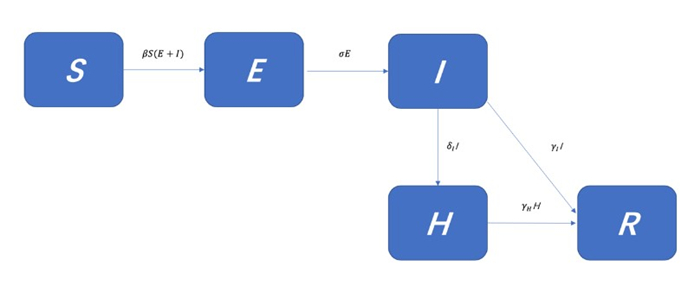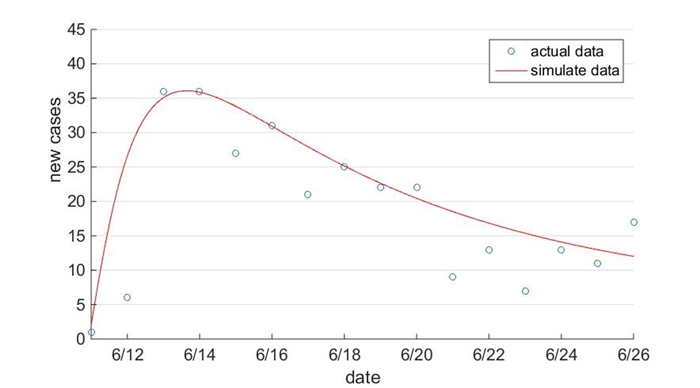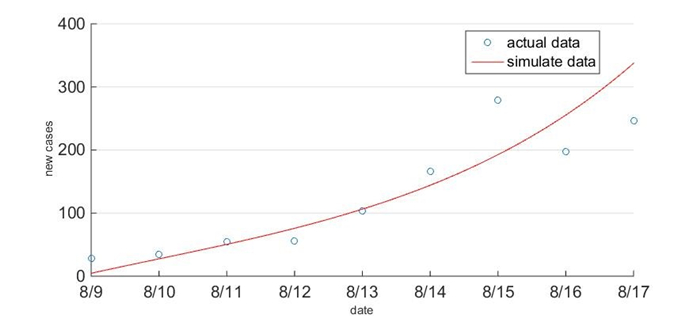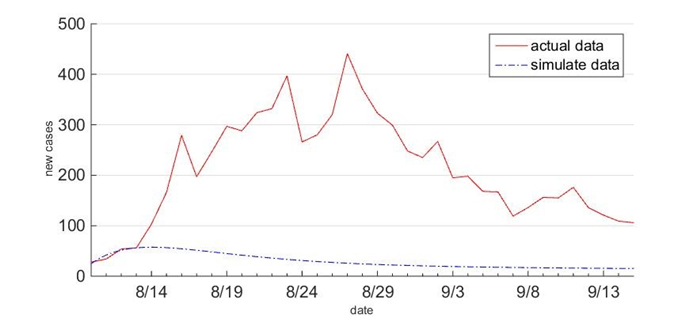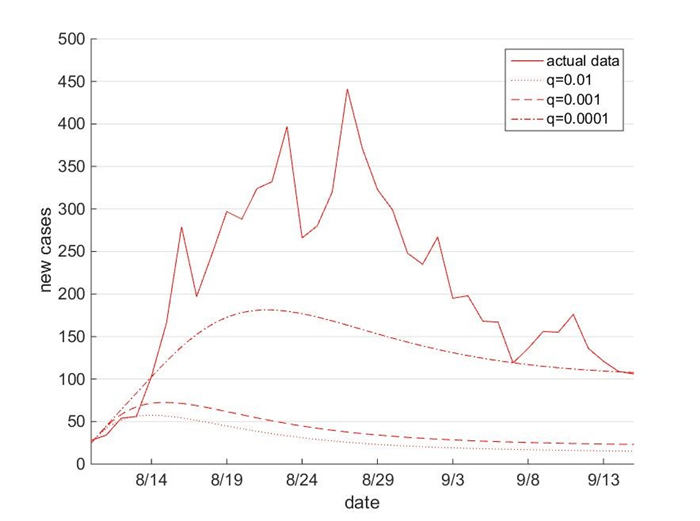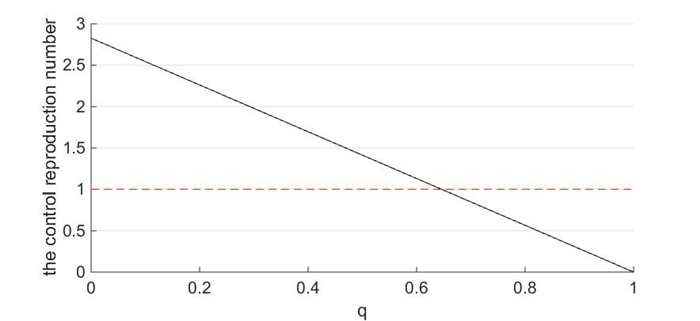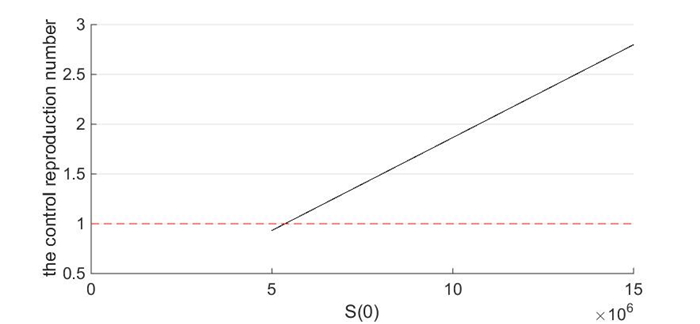| Citation: | Chuanqing Xu, Zonghao Zhang, Xiaotong Huang, Jing'an Cui, Xiaoying Han. THE DYNAMIC EFFECTS OF DIFFERENT QUARANTINE MEASURES ON THE SPREAD OF COVID-19[J]. Journal of Applied Analysis & Computation, 2022, 12(4): 1532-1543. doi: 10.11948/20210326 |
THE DYNAMIC EFFECTS OF DIFFERENT QUARANTINE MEASURES ON THE SPREAD OF COVID-19
-
Abstract
COVID-19 is pandemic worldwide, and different countries have adopted different measures to stop the spread of the epidemic. In order to study the impact of quarantining close contacts on the spread of coronavirus disease 2019 (COVID-19), based on data published by Beijing Municipal Health Commission, World Health Organization (WHO) and Korea Central Disaster Control Headquarters (KCDC), SEIR dynamic models of virus transmission in Beijing and South Korea were set up respectively; the Genetic algorithm was used to fit the important parameters such as transmission rate, recovery rate and quarantine rate; calculated the control reproduction number; we discuss the impact of quarantining close contacts on daily new cases in South Korea, the daily new cases decrease after a week, and drop to 16.93 after 30 days. When close contacts were quarantined, the maximum value of daily new cases $ I_{max}=57.4 $ obtained by simulation is only 13% of the actual maximum value actual $ I_{max}=441 $; the influences of different quarantine rates and the number of the susceptible on the number of daily new cases are also discussed, the quarantine of close contacts has significant effect on reducing the number of daily new cases compared with less stringent control measures. Vigorous control measures reduce the number of daily new cases to single digits in just 17 days in Beijing, effectively curbing the transmission of COVID-19. It has vital significance for the prevention and control of the epidemic in other countries and regions.
-
Keywords:
- COVID-19 /
- close contacts /
- SEIR model /
- reproduction number
-

-
References
[1] F. Brauer and C. C. Chavez, Mathematical Models in Population Biology and Epidemiology, Springer, New York, 2012. [2] Beijing Municipal Health Commission, News center[EB/OL], 2020, http://wjw.beijing.gov.cn/xwzx_20031/wnxw/. [3] S. Cao, P. Peng and P. Shi, Study on the epidemic development of COVID-19 in Hubei province by a modified SEIR model, Journal of Zhejiang University (Medical Sciences), 2020, 49(02), 178–184. [4] J. Cui, J. Lv, S. Guo and T. Chen. Dynamical Model of Emerging Infectious Diseases applied to COVID-19 Transmission, Acta Mathematicae Applicatae Sinica, 2020, 43(02), 147–155. [5] Y. Chen, Q. Liu and D. Guo, Emerging coronaviruses: Genome structure, replication, and pathogenesis, Journal of Medical Virology, 2020, 92(10), 2249– 2249. doi: 10.1002/jmv.26234 [6] China-World Health Organization Joint Investigation Team for COVID-19, Report, China Social Security, 2020(04), 11. [7] N. M. Ferguson, D. Laydon and et al, Impact of non-pharmaceutical interventions (NPIs) to reduce COVID-19 mortality and healthcare demand, Imperial College COVID-19 Response Team, 2020. DOI: 10.25561/77482. [8] D. S. C. Hui and A. Zumla, Severe Acute Respiratory Syndrome: Historical, Epidemiologic, and Clinical Features, Infectious disease clinics of North America, 2019, 33(4), 869–889. doi: 10.1016/j.idc.2019.07.001 [9] Korea Central Disaster Control Headquarters, COVID-19[EB/OL], 2020, http://ncov.mohw.go.kr/cn/. [10] Q. Lin, S. Zhao and et al, A conceptual model for the coronavirus disease 2019 (COVID-19) outbreak in Wuhan, China with individual reaction and governmental action, International Journal of Infectious Diseases, 2020, 93, 211–216. [11] E. Shim, A. Tariq, W. Choi, Y. Lee and G. Chowell, Transmission potential and severity of COVID-19 in South Korea, Int. J. Infect. Dis., 2020, Apr, 93, 339–344. [12] B. Tang, X. Wang, Q. Li, N. L. Bragazzi, S. Tang, Y. Xiao and J. Wu, Estimation of the Transmission Risk of the 2019-nCoV and Its Implication for Public Health Interventions, Journal of Clinical Medicine, 2020, 9(2), 462. doi: 10.3390/jcm9020462 [13] S. Tang, Y. Xiao, Z. Peng and H. Shen, Prediction modeling with data fusion and prevention strategy analysis for the COVID-19 outbreak, Chinese Journal of Epidemiology, 2020, 41(04), 480–484. [14] E. Wit, N. Doremalen, D. Falzarano and V. J. Munster, SARS and MERS: recent insights into emerging coronaviruses, Nature Reviews Microbiology, 2016, 14(Suppl. 1), 523–534. [15] M. Willman, D. Kobasa and J. Kindrachuk. A Comparative Analysis of Factors Influencing Two Outbreaks of Middle Eastern Respiratory Syndrome (MERS) in Saudi Arabia and South Korea, Viruses, 2019, 11(12), 1119. doi: 10.3390/v11121119 [16] World Health Organization, Health Topics[EB/OL], 2020, https://covid19.who.int. [17] S. Wang, H. Tan and D. Li, Coronavirus disease 2019 epidemic trend prediction based on improved infectious disease dynamics susceptible-exposed-infectedrecovered (SEIR) model, Academic Journal of Second Military Medical University, 2020, 41(06), 637–641. -
-
- Figure 1. Curve of daily new confirmed COVID-19 cases in Beijing and Korea.
- Figure 2. Diagram of the model adopted in this study for simulating the COVID-19 in Beijing. Interventions including intensive contact tracing followed by quarantine and isolation are indicated.
- Figure 3. Diagram of the model adopted in this study for simulating the COVID-19 infection in south Korea. The tracking and quarantine of close contacts are not considered.
- Figure 4. Actual data and fitting images (Beijing).
- Figure 5. Actual date and fitting images (Korea).
- Figure 6. Tracking and quarantine measures are added to Model (2.2).
- Figure 7. Simulate the impact of different quarantine ratios on new daily cases.
-
Figure 8. The impact of the quarantine ratio
$ q $ on the control reproduction number. - Figure 9. The impact of the susceptible on the control reproduction number.
- Figure 10. The impact of the number of the susceptible on the number of daily new cases.



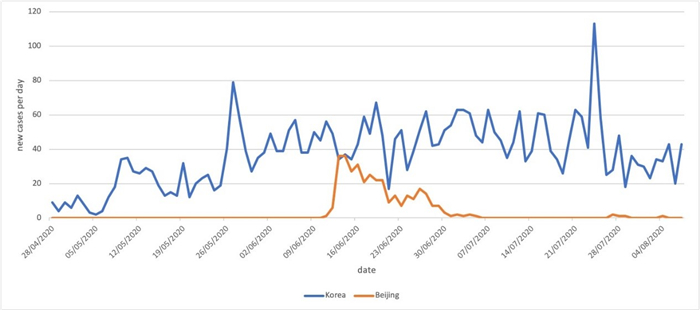

 DownLoad:
DownLoad:
